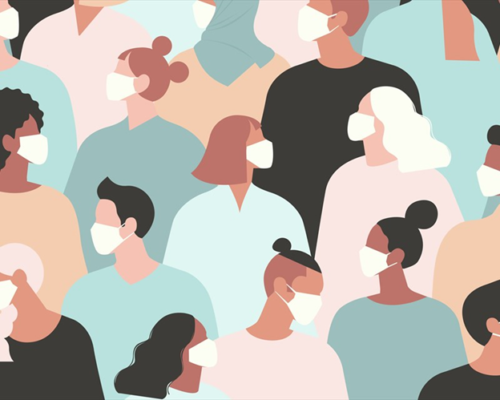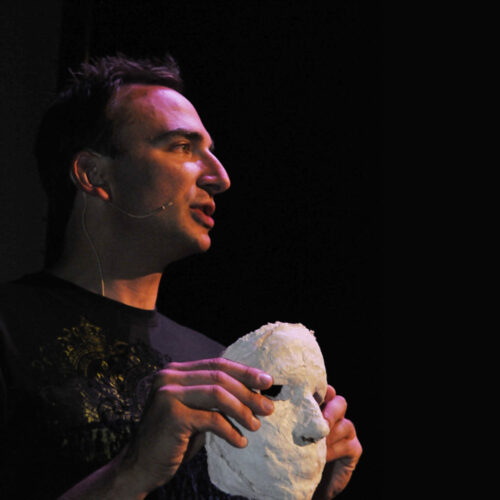“The smile beneath the mask—or how to communicate emotion while most of our faces are covered up.”
I’m doing all I can to accept the new normal of mask-wearing 2020. Don’t get me wrong. I believe in all the life-saving reasons. I really do. Thing is, along with trying to breathe while dealing with a chronic sinus thing and a lifelong claustrophobia condition about mask-wearing I face stuff that I hate to face on my face.

But the non-smiling thing. It’s alienating. Even punishing. I love smiling at people and love the smile back. I miss it all. And forget about those goofy masks with painted smiles across them that only give me nightmares. Like trying to cozy up to Chucky. No, I just miss the genuine, warm-hearted smiles.
I mean, I come from a very smiley, huggy family (don’t get me started missing the hugs!) And now? Yes, we’re meant to focus on the twinkly eyes. The warmth of conversation—six feet away. The hand wave. All substitutes for that good, old-fashioned, grin from ear-to-ear.
Are smiles important? Actually, in many ways, they are according to the world of science. Smiling is not only contagious it stimulates our mirror neurons to suppress our facial muscle control that triggers smiles. And the extra good thing about smiling is that it’s good for our health—reducing anxiety, as well as even lowering blood pressure and heart rate! According to scientific studies, smiling stimulates our brain’s reward mechanisms in a way—you’re not going to believe this—that even chocolate (a well-regarded pleasure-inducer) cannot match.
I know this and yet loving animals as I do not many are known for being smiley. Certainly not cats. I love our Maine Coone cat, Boo, insanely, but though he shows his love in so many ways it’s definitely not in a toothy grin. In fact, other than many primates, and some canines, most animals from turtles to Toucans have entirely unique ways of smiling without smiling. Even my darling husband, Pete, who has one expression for a variety of feelings—rarely smiles or laughs out loud—and yet I’ve learned that his happy vibes are, literally, masked underneath a very caring and loving soul. Still waters do run deep at least with him—being a fly-fishing river guide–it’s true.
This mask-mania has caused me to think even more about what happens to the individual when forced to hide behind a variety of real or imagined masks. Facial expressions may be hidden like the covered-up smiles, but what is gained and lost in the process? Masks have been an essential part of the theatrical world since the beginning of the dawn of Greece.

I decided to have a sit-down with my son, Jesse Wilson –a communication specialist, human connection, and speaking coach – who works with inmates, addicts, business professionals, and trial lawyers. For many who have worked with Jesse, he’s known as “The Mask Guy.” Jesse uses every “tool” from the stage to help individuals find and express their truest, most authentic selves, and that includes using mime, movement, monologues, and, you got it, masks. Lots and lots of masks. I wanted to learn more about the power behind them. Maybe if I understood not just the anti-Covid-ing significance of mask-wearing, but even more, the deeper power of putting on and taking off something that transforms us in so many ways. I needed to embrace rather than fight a reality that is far more edifying than suffocating.
So I asked Jesse:
Cara: You use masks in just about all your work in preparation for the courtroom, all your workshops, personal coaching and more. I’m curious about how emotion is expressed when wearing a mask? I know that in this COVID time there is no physical interaction, so the mask-wearing has to be a singular entity, right? What is your thinking behind/underneath it all?
Jesse: In the mask workshops, one of the best things the person wearing the mask can hear is the audience express the words, “After awhile, we forgot you were even wearing a mask!” This transformation occurs when the person wearing the mask makes the powerful emotional shift… so that their energy comes from their entire being… not the mask. Though I coach many individuals, the thinking behind it is the same—before you begin to stand in that courtroom, or prison, or rehab center, or anywhere you are speaking, you have to find the underlying emotion first. The storyteller is lost without the story. And that is not a singular, cerebral expression. It must be telegraphed with the entire body. Your audience needs to feel what you are wanting them to feel. That’s one of the main challenges of wearing masks. The challenge of the mask is also the solution… trusting the power of the emotion. Ironically, we rely way too heavily on the face… rather than trusting what lies behind it.
Cara: So, what would you say is the main emphasis you coach individuals to know about putting on and removing their masks?
Jesse: Masks are a way of centering us—to find the true emotion that’s inherent in each of us. Non-verbal expression comes from a place that forces you to feel your own feelings and telegraph that feeling without words or facial expressions at all.
I work with both character masks and neutral masks. We start out putting on a mask that has some kind of exaggerated facial expression allowing you to move your body and voice in a way the mask triggers emotion. From there we eventually use the neutral mask—with no facial expression that forces you to come from a deeper truth that you might have been “masking” from yourself and the world all your life.
Character masks train you for the neutral mask. The goal is to find the emotion in your body. Non-verbal expression comes from the emotional state that is in all of us. The challenge is to telegraph that emotion with your body, your voice, your eyes—but not your face.
I believe that in our present daily mask-wearing we will come to a place in society where we feel each other’s emotions rather than see them. The mask forces us to feel more than what we’ve relied upon up to now. The mask trains everyone to slow down, to see and feel a truth from another dimension… and that other dimension is within us! And even though we might hate it, something good might actually evolve from this strange mask-wearing-society we’re forced to “face.” The challenge for all of us is to look deeper… to look at the real person behind the mask. And to listen with our entire being. I believe that this time we’re in right now– with all the pain, fear, and heartbreak that’s going on the world—has given us an incredible opportunity to empathize at levels we need to be operating at if we are to co-exist with one another. As we all wear our literal masks for safety purposes, all of us need to remove our metaphorical masks!
Here are a few tips you can be applying to your daily life right now that will help you remove your mask:
- With your MASK ON (your COVID protector mask), challenge yourself at least once a week to begin a socially-distanced conversation with a stranger for more than two minutes. Hold their eyes. See if you can make them smile with a joke, a memorable moment, a compliment. Hold yourself accountable to increasing your awareness of the smile in your body—your hands, your feet. Ask yourself, “Do I feel this smile beyond my face?”
- Take a dance, yoga, or any kind of “physical expression” workshop online (there are millions of them now). Even though it will be hot, sticky, and uncomfortable, slip your mask on while moving. Pay attention to your body. Allow yourself to move with even greater emotion. Fluctuate between Mask On and Mask Off.
- Take an improvisation class online. Non-verbal expression is a major component of improv. Improvisation will allow you to increase your awareness of your body, and the non-verbal expressions of the people around you.
- Take a singing class online. Request from your instructor to sing with the mask on. It’s up to you to tell the instructor your intentions with the mask—but the mask on your face will force you to make a greater emotional connection to what is “beyond the notes.” Keep in mind, the purpose of the class should not be about being a “good singer” unless that’s in alignment with your creative or professional goals. It’s about making the emotional connection.
After my talk with Jesse I’m challenged to see my face mask as a game-changer, a chance to see and be seen in a whole new way. How may I communicate feelings—a real smile from the core of my being not just face muscles—to others? The stage is set. Challenge accepted!
